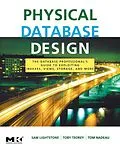The rapidly increasing volume of information contained in relational databases places a strain on databases, performance, and maintainability: DBAs are under greater pressure than ever to optimize database structure for system performance and administration. Physical Database Design discusses the concept of how physical structures of databases affect performance, including specific examples, guidelines, and best and worst practices for a variety of DBMSs and configurations. Something as simple as improving the table index design has a profound impact on performance. Every form of relational database, such as Online Transaction Processing (OLTP), Enterprise Resource Management (ERP), Data Mining (DM), or Management Resource Planning (MRP), can be improved using the methods provided in the book. - The first complete treatment on physical database design, written by the authors of the seminal, Database Modeling and Design: Logical Design, Fourth Edition - Includes an introduction to the major concepts of physical database design as well as detailed examples, using methodologies and tools most popular for relational databases today: Oracle, DB2 (IBM), and SQL Server (Microsoft) - Focuses on physical database design for exploiting B+tree indexing, clustered indexes, multidimensional clustering (MDC), range partitioning, shared nothing partitioning, shared disk data placement, materialized views, bitmap indexes, automated design tools, and more!
Autorentext
Sam Lightstone is a Senior Technical Staff Member and Development Manager with IBM's DB2 product development team. His work includes numerous topics in autonomic computing and relational database management systems. He is cofounder and leader of DB2's autonomic computing R&D effort. He is Chair of the IEEE Data Engineering Workgroup on Self Managing Database Systems and a member of the IEEE Computer Society Task Force on Autonomous and Autonomic Computing. In 2003 he was elected to the Canadian Technical Excellence Council, the Canadian affiliate of the IBM Academy of Technology. He is an IBM Master Inventor with over 25 patents and patents pending; he has published widely on autonomic computing for relational database systems. He has been with IBM since 1991.
Inhalt
1 Introduction to Physical Database Design
2 Basic Indexing Methods
3 Query Optimization and Plan Selection
4 Selecting Indexes
5 Selecting Materialized Views
6 Shared-nothing Partitioning
7 Range Partitioning
8 Multidimensional Clustering
9 The Interdependence Problem
10 Counting and Data Sampling in Physical Design Exploration
11 Query Execution Plans and Physical Design
12 Automated Physical Database Design
13 Down to the Metal: Server Resources and Topology
14 Physical Design for Decision Support, Warehousing, and OLAP
15 Denormalization
16 Distributed Data Allocation
Appendix A A Simple Performance Model for Databases
Appendix B Technical Comparison of DB2 HADR with Oracle Data Guard for Database Disaster Recovery
